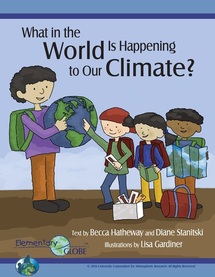GLOBE Connections
Elementary GLOBE - Earth System
As elementary students explore phenomena in My NASA Data, these additional Elementary GLOBE resources will help deepen their understanding. Elementary GLOBE is designed to introduce students in grades K-4 to the study of Earth system science. Therefore, storybooks may align with more than one sphere in My NASA Data and GLOBE.
Each module of Elementary GLOBE includes:
- A science-based fictional storybook in which kids explore an aspect of the Earth system using their science skills.
- Three learning activities that further explore the science content while helping students develop science and engineering practices.
- Teacher’s notes and a glossary to give educators basic science background information pertaining to each module topic.
The Teacher Implementation Guide provides an overview of Elementary GLOBE, the connections that the curriculum makes to literacy, the use of science journals, elementary science inquiry, standards alignment, and connections to other parts of the elementary curriculum.
Translated versions: GLOBE makes every effort to provide translations of our materials in the official U. N. languages. Currently, Elementary GLOBE materials are available in Arabic, English, French, German, Norwegian, and Spanish. Click on the language to access the translated Elementary GLOBE materials. Please note that not all storybooks and activities have been translated. If you would like to add your language to this list, please contact us at help@globe.gov for information about how to get approval to create materials in other languages.
Air Quality
In this storybook, the GLOBE Kids investigate colors in the sky and learn how air pollution affects sky color and our health. Learning activities engage students in describing sky color and conditions in the atmosphere, creating a model to learn how sky color and visibility are affected by aerosols, using prisms to explore properties of light and colors, and collecting aerosol samples.
An interactive version of the Why (Not) So Blue activity is available in My NASA Data. It is called Sky Color and Visibility.

Climate
This storybook follows the GLOBE Kids as they take an adventure and learn that climate change affects the whole world, from the tropics to the poles. Through learning activities, students learn how the weather over a long period of time describes the climate, explore how sea-level rise can affect coastal communities and environments, and describe how humans are contributing to climate change and how we can take action to solve this problem.
An interactive version of Weather Adds up to Climate is available in My NASA Data. It is called Interactive Weather Observations.

Clouds
In this book, descriptions of cloud types are combined with analogies related to cloud shapes and are acted out by the GLOBE Kids. Activities give students the opportunity to describe the shape and appearance of cumulus clouds and learn the types of weather that are associated with cumulus clouds. They identify cloud types using cloud classification names and explore the three types of contrails.
An interactive My NASA Data activity that supports clouds is Modeling Cloud Cover.

Earth System
This storybook follows the GLOBE Kids as they prepare to perform a play about the parts of the Earth system. However, the kids argue about which part is most important and should have the lead role in the play. Activities help students experiment with what plants need in terms of water, sunlight, and soil, explain how the Earth’s processes and components are interconnected, and demonstrate their knowledge of how water, air, soil, and living things interact in the Earth system.

Seasons
In this story, the GLOBE Kids wonder why hummingbirds have stopped visiting their school. They learn about the needs of the hummingbirds, the seasonal changes where they live, and the environment where the hummingbirds spend the winter. Through learning activities, students describe the seasonal changes in a local habitat, observe how colors in nature change through the seasons, and research hummingbirds.

Soils
In this storybook, the GLOBE Kids are on the trail of Scoop, an eager dog who loves to dig holes in the soil. At each hole Scoop has dug, the Kids use their journals to record characteristics of the soil. Learning activities help students explore and describe soil, consider what is found in soil such as rocks, roots, critters, and organic material, and explain the importance of soil to plants and animals.

Water
The GLOBE Kids find that Willow Creek looks different than it did the last time they visited. In the storybook, they make observations, take measurements, and look for critters to describe the creek. Learning activities allow students to learn about tools for making science observations such as a magnifying lens and ruler. Then students describe how macroinvertebrates are adapted to their aquatic environment.

Source: Elementary GLOBE

